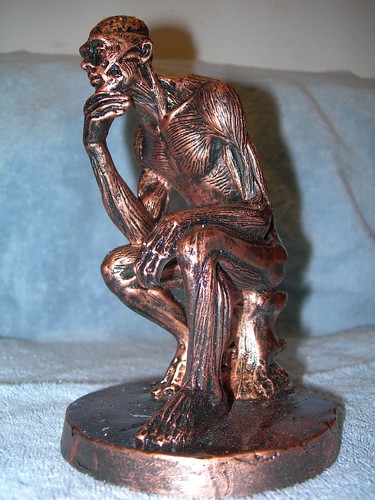
Bodies...The Exhibition is a touring show highlighting the anatomical structure of the human body.
A University in China accepts unclaimed bodies from the government and preserves them through a process called plastination. Using silicon, acetate, and other materials, they preserve the structures of the body in such a way that they can be displayed in full or in part in a museum.
Make no mistake -- the bodies in this show are real. People who were born, grew up, lived their lives, and subsequently died in China are now preserved and traveling the country for the general public to see and study.
This is the last week of the Seattle exhibit. Next weekend, they put the people and various people parts into boxes and take the show to San Diego.
So it was crowded when my GF and I went to the show today.
It was a fascinating show. The divided it into multiple rooms showing different organ groups. The first area focused on the bones and muscles. Another room was all about the nervous system and brain. The circulatory system, digestive system, respirtory system and reproductive system also had their own rooms.
Most rooms had one or more full bodies opened up so you could see each of the organs they were talking about.
These bodies stand right in the room. There is no Plexiglas case around them. You could reach right in and touch the insides of these people. Of course there are signs in front of each body that say "Please do not touch" and, since it's Seattle, nobody touched.
Most of the bodies are in action poses -- throwing a Frisbee, pitching a baseball, or swinging a tennis racket, for example. You can see which muscles are contracting and which are relaxing. You can see how they relate to one another.
In the first room, they have what looks like 2 bodies supporting one another. It's actually just one body, though. His skeleton has been separated from his muscles. And the full set of muscles is looking at the full skeleton.
In addition to the bodies, they have body parts throughout the exhibit, though these are in cases. For example, they have legs and arms with out the skin. They also have limbs sliced in half or opened up in other ways so you can see how things like the wrist or knee work.
The circulatory system was fascinating. They used a different process here. Basically they injected a substance into the blood vessels that hardened and preserved them. Then they used other substances to dissolve away the rest of the tissue. This leaves behind just the blood vessels preserved in their original shape -- like red ghosts of the people they used to inhabit. Considering how small and delicate most of the 60,000+ miles of blood vessels are, it's amazing we don't bleed to death each time we walk into a wall. Or wear a hat that's too tight.
They also had a section set aside for embryonic/fetal development. They posted a sign outside that room explaining that all the bodies in there were from children who died due to complications during pregnancy or unsuccessful fetal surgery. They also offered a second door through the exhibit so those who were uncomfortable with those bodies or birth defects could skip it and continue though the hall.
Here I have some difficulty wrapping my head around the extra sensitivity with which exhibitors have to treat the bodies in this room while being a part of a culture that allows legal abortion.
I learned quite a few things at the exhibit.
Most organs in the human body are either much smaller or much larger than I expected.
The brain is significantly smaller than I imagined.
The lungs are much smaller and higher in the chest cavity than I thought.
The three bones in the ear are really small. And yet highly sensitive.
The uterus is really tiny when not in active use.
The liver is much bigger than I thought. And it's the largest internal organ, often coming in at more that 2 pounds.
The lungs are designed in a modular fashion. Each section works independently of the others, making it possible to remove just parts of a lung.
There is a lot of complicated stuff packed into a very small space in the chest cavity.
The navel of an adult is huge, especially when you separate much of the surrounding skin.
The creepiest thing I saw was the skin display. Without the structure of bone and muscle, it looked like some sort of Halloween costume, which I guess it is.
There were some strange things, too. The eyes in the displays were a little disconcerting. I don't know if they were the actual eyes the people had or if they were artificial. I'm guessing artificial because they were a little too perfect.
Several of the bodies still had eyebrows or eyelashes. And some of them still had toenails.
The other interesting part of the show was the crowd. There were plenty of adults and children there. The kids generally seemed fascinated, listening to the description on their museum audio tour sticks. A few seemed bored. None of them seemed disturbed by the show.
Most of the adults attending also seemed interested, though several of them looked a bit tense as well.
Many of the attendees were medical professionals explaining the details of the parts and bodies to their bored friends and relatives.
One of the displays was of a Teratoma, which is some sort of tumor. One women called out to here friend, "Oh, cool! Look -- an actual teratoma!" The friend excitedly rushed over and agreed that it indeed was quite cool and exciting.
It was a good show. I appreciated the opportunity to see how the body is put together and get a look at these normally hidden parts. I don't know if it's the type of show I can say I really "enjoyed" -- that would seem a bit disrespectful of the people whose insides we were looking at. But I'm glad I went and can definitely recommend it.
-----
I should mention that the show is controversial for a few reasons. There are occasional protesters in front of the building. The Seattle PI discussed some of these in its mostly positive review.
But critics say this show and others like it don't so much educate as they do desecrate the human body for profit.
"Premier is a for-profit company. What they're trying to do is make money for a corporation," said Philip Lipson, a Seattle resident who Tuesday stood outside the soon-to-be-opened exhibit distributing protest fliers.
Meanwhile, members of human-rights watchdog groups and some members of Seattle's Chinese community have expressed concern that, not only do the bodies come from a country with a long history of human-rights abuses, but the people whose bodies were used did not give permission for their bodies to be put on display.
"I'm troubled by the fact the bodies are from China," said Ron Chew, executive director of the Wing Luke Asian Museum. "There are a lot of issues there."
"From a cultural perspective, especially since a number of the cadavers are from China, it feels like a gross violation," said Bettie Luke, who works with various Seattle Chinese American groups. "The willful use of putting a body on indefinite display like that condemns the soul to wander the netherworld with no chance to rest."
...
Markel and others are concerned that shows like this do not use bodies from consenting donors and do not make public the paper trail showing exactly where the cadavers came from.
"I'm all in favor of people looking at and understanding the human body," he said, but added that he thinks there are other ways, besides public spectacle, to educate people about their inner workings. "Frankly, I don't want to be somebody's Saturday entertainment."
Oddly enough, the most vocal critics of the Seattle show so far are Philip Lipson and his partner Charlette LeFevre, operators of the Seattle Museum of the Mysteries, a Capitol Hill museum that features exhibits on Bigfoot and UFOs and also hosts ghost tours.
"We feel that this group is not honoring the dead," Lipson said. "It's not treating them with dignity and is just making a peep show out of dead bodies."
...
"This Seattle exhibit is deeply flawed," Aaron Ginsburg, a pharmacist from Massachusetts, wrote in an e-mail to the P-I. "The bodies were not donated, and may well have belonged to political prisoners. China is not a nation of laws, and any assurances that the bodies were legally obtained is meaningless."
Ginsburg has started a nationwide Web site protesting the various body exhibits with a portion of the site dedicated to the Seattle show: http://dignityinboston.googlepages.com/seattle.
Tan Truong, a Seattle practitioner of Falun Gong, a spiritual movement banned in China, also is worried about the origin of the cadavers.
Though Truong admits there's no proof the bodies are those of imprisoned Falun Gong practitioners or other enemies of the Communist government, he said, "You just don't know what kind of bodies you're getting from China because there's not a lot of regulation. There's a lot of organ harvesting."
But Glover insisted, "We are not using the bodies of executed prisoners. We are not using the bodies of anyone that belongs to (the Falun Gong). We are very sympathetic to the cause of the Chinese people that are undergoing the violations of their rights. But because we have a partner in China does not mean we are part of the problem."
Dalian Medical University receives the bodies from the government, Glover said. That's because when a person dies in China and there's no one to claim the remains, the government allows the body to be used for medical study.
Glover insists that all the people died from natural causes (including disease). He also said Premier has spent "considerable time" investigating the university. And Zaller said Premier has contracts with the university certifying that the bodies are not those of former prisoners or people from mental institutions. (Premier does not, however, show its contracts to the media.)
Glover points out that the Chinese government's gifting of unclaimed bodies to universities for study and education is not dissimilar to practices in much of the United States. Unclaimed bodies here often are used for medical study and education, though that does not appear to include use in any of these traveling shows.
One of the complaints is that the exhibit can't be educational because it's put on by a company using it to make money. Education and profit are not mutually exclusive however. But that is a rant for another day.

1 comment:
FLG disciple Tan Truong's statment is contradictory at the least. He mentioned organ harvesting, but he has no proof - while the exhibit is showing bodies with organs in tact.
Also, Falun Gong allegation has been discredited by multiple undercover investigations.
US government and Chinese dissident investigations:
1) http://www.zonaeuropa.com/20060806_1.htm
http://www.cicus.org/news/newsdetail.php?id=6492
2) http://usinfo.state.gov/xarchives/display.html?p=washfile-english&y=2006&m=April&x=20060416141157uhyggep0.5443231&t=livefeeds/wf-latest.html
http://www.usembassy.it/pdf/other/RL33437.pdf (section CRS-7)
3) http://crc.gov.my/clinicalTrial/documents/Proposal/TCM_Stroke%20TrialProtocol%20synopsis.pdf (page 3)
As you can see, the hospital Falun Gong accused is partly owned by a Malaysian health care company and is subject to oversight beyond Chinese authority.
Post a Comment